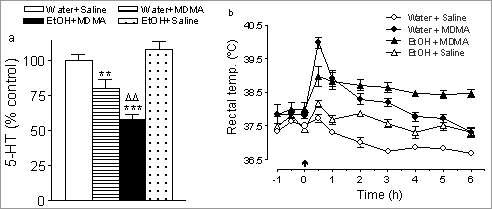Exposure to intermittent ethanol vapour enhances the MDMA-induced long-term neurotoxicity
Ethanol (EtOH) use is prevalent among consumers of ecstasy, with over 70% drinking at hazardous levels (Winstock et al., 2001). 3,4-Methylenedioxymethamphetamine (MDMA, ‘ecstasy’) and EtOH are both capable of producing oxidative stress and neurodegeneration (Green et al., 2003; Fadda & Rossetti, 1998). We have examined whether pre-exposure to EtOH vapour enhances 5-HT neurotoxicity induced by a low dose of MDMA when administered at high ambient temperature to mimic human consumption. Adult male Dark Agouti rats (150-175 g) were placed into 37 litre chambers and exposed to water (controls) or EtOH vapour (3 h/day) for 3 days. EtOH was delivered at a flow rate of 1.5 ml/min. Blood EtOH levels were determined every day immediately after the 3-h period of EtOH exposure. Twenty-four h after the last EtOH exposure rats were placed in a room temperature of 28-30ºC for 2.5 h before MDMA (5 mg/kg, i.p.) injection and for 6 h after. Rats were killed 7 days later and cortical and hippocampal 5-HT concentration quantified by h.p.l.c. Seven days after injection MDMA produced a significant reduction in 5-HT concentration of cortex (Figure 1a) and hippocampus. This effect was significantly enhanced in rats pre-exposed to ethanol vapour (Figure 1a). Pre-exposure to EtOH reduced the initial hyperthermic peak but maintained a more pronounced hyperthermia between 2-6 h after MDMA injection (Figure 1b). Plasma EtOH levels ranged between 546±31 mg/dl and 737±45 mg/dl (mean ± s.e.mean, n = 12). These data indicate that repeated EtOH intoxication alters the temperature response to MDMA and this causes greater neurotoxicity.
Figure 1. Effect of pre-exposure to EtOH or water vapour on MDMA-induced changes in cortical 5-HT and rectal temperature. Results shown as mean ± s.e.mean, n= 6-11. Different from saline: **P<.0.01, ***P<0.001 (Newman-Keuls test). Different from MDMA: ΔΔP <0.01. MDMA produced hyperthermia F(1,19)=90.66, P<0.001 that was enhanced by pre-exposure to EtOH vapour in the interval 2-6 h F(1,15)=20.71, P<0.001 (2-way ANOVA).
Green, A.R. et al., (2003) Pharmacol Rev. 55: 463-508. M.I.C. thanks PNSD (MSC), MCYT ( SAF2004-02603) and FIS ( G03/005) for support. * Permanent address: F. Medicina, U. Valparaíso, Hontaneda 2653, Valparaíso, Chile. |


